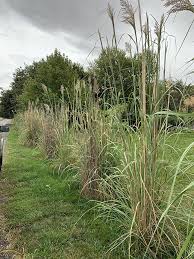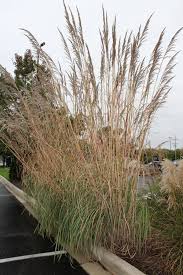Ravenna Grass, scientifically known as Saccharum ravennae, is a tall and graceful plant that can add a touch of elegance to gardens and landscapes. Its feathery plumes and sturdy stems make it a favorite among garden enthusiasts. This ornamental grass is native to the Mediterranean region and has gained popularity for its aesthetic appeal and ease of cultivation.
With its scientific name derived from the Latin word “Saccharum” meaning sugar cane, Ravenna Grass belongs to the Poaceae family, which includes other grasses like bamboo and sugarcane. Despite its common name, Ravenna Grass is not a true grass; rather, it is classified as a large perennial grass-like plant. Its tall stature, reaching up to 10 feet (3 meters) in height, adds vertical interest to landscapes and creates a striking visual impact.
One of the standout features of Ravenna Grass is its plumes. These plumes, often resembling large, soft feather dusters, emerge in late summer and persist through the fall. The plumes start as tightly packed buds and then unfurl into airy, feathery structures that sway gracefully in the wind. These plumes come in various shades, ranging from creamy white to soft pink or even pale purple, adding a spectrum of colors to the landscape.
Caring for Ravenna Grass is relatively simple, making it a great choice for both experienced gardeners and beginners. It thrives in full sun but can tolerate partial shade, and it is adaptable to a variety of soil types as long as they are well-draining. Once established, Ravenna Grass is relatively drought-tolerant, requiring minimal watering. However, providing adequate moisture during its initial growth phase helps ensure healthy establishment.
In colder climates, Ravenna Grass may die back in winter, but it tends to resprout in the following spring. To maintain its neat appearance and encourage new growth, it’s a good practice to prune the grass down to a few inches above the ground in late winter or early spring before new growth emerges.
Incorporating Ravenna Grass into your landscape design can bring a sense of movement and drama. Planted as a focal point or used as a backdrop for lower-growing plants, it can create a dynamic contrast in height and texture. Additionally, Ravenna Grass can be used in large containers to add a touch of sophistication to patios and balconies.
In addition, Ravenna Grass, or Saccharum ravennae, offers a captivating blend of height, texture, and color to any outdoor space. Its tall plumes and graceful demeanor make it a sought-after addition to gardens, providing a natural and picturesque element that captures the eye and soothes the senses. With its low-maintenance requirements and versatility in design, Ravenna Grass can be a wonderful choice for anyone looking to enhance their landscape with a touch of nature’s beauty.
Read Also: The Best Source of Water for Fishes in Concrete Ponds
Growing Ravenna Grass

Here’s a simple growing guide for Ravenna Grass:
1. Choosing a Spot: Find a place in your yard or garden that gets sunlight. Ravenna Grass likes sunshine, but it’s okay if it’s a bit shady sometimes.
2. Planting Time: You can plant Ravenna Grass in spring or early summer when it’s getting warm outside. Make sure there’s no more frost.
3. Preparing the Soil: Dig a hole in the ground or in a pot. The hole should be as deep as the plant’s root ball. The root ball is the clump of soil around the plant’s roots. Make the hole a little wider than the root ball too.
4. Planting the Grass: Take the plant out of its pot carefully. Put it in the hole you dug. Fill the hole with soil and pat it gently around the plant. Give it a bit of water to help it settle in.
5. Watering: Water the grass after planting it. Then, water it when the top inch of soil feels dry. Don’t overwater, because Ravenna Grass doesn’t like to sit in soggy soil.
6. Growing Tall: As the grass grows, it might need a bit of support, especially if it’s windy. You can use stakes to help it stand up straight.
7. Pruning: When winter comes, the grass might turn brown and look sleepy. You can trim it down to a few inches above the ground. This helps it grow nicely in the spring.
8. Enjoying the Fluffy Feathers: In late summer and fall, the grass will grow tall and fluffy plumes. These are the pretty feather-like parts. Enjoy watching them sway in the breeze!
9. Dividing the Grass: After a few years, the grass might get too big. You can divide it by digging it up and splitting it into smaller clumps. Then you can plant the new clumps in different spots.
Remember, growing plants can be a fun adventure! Just give your Ravenna Grass some care, a bit of water, and a sunny spot, and it will reward you with its beautiful feathery plumes.
Caring for Ravenna Grass
Here’s a simple care guide for Ravenna Grass:
1. Sunlight: Find a spot where your Ravenna Grass can get sunlight for most of the day. It loves sunshine, but a bit of shade won’t bother it too much.
2. Watering: Give your grass a drink of water after you plant it. After that, water it whenever the top part of the soil feels dry. Stick your finger in the soil about an inch deep – if it’s dry, then it’s time to water. But don’t go overboard; too much water can make the grass sad.
3. Soil: Ravenna Grass is flexible about soil, but it likes well-draining soil best. If water doesn’t stay pooled on the ground after it rains, your grass will be happy.
4. Feeding: You don’t need to feed your grass too much. A sprinkle of slow-release fertilizer in spring is usually enough. Read the label on the fertilizer bag to know how much to use.
5. Trimming: When winter comes, the grass might look tired and brown. That’s okay! Cut it back to a few inches above the ground. This gives it a fresh start when spring arrives.
6. Staying Upright: If your grass gets really tall, it might need some help to stay standing. You can use stakes or a light trellis to keep it from flopping over.
7. Dividing: After a few years, your grass could become crowded. When that happens, you can dig it up, split it into smaller clumps, and put those clumps in different spots. It’s like giving your grass more room to grow.
8. Enjoy the Show: In late summer and fall, your grass will grow those fluffy plumes that look so pretty. Just sit back and enjoy the show as they dance in the breeze.
9. Winter Preparations: If you live in a really cold place, you might want to mulch around the base of the grass before winter. Mulch is like a cozy blanket that keeps the roots warm.
10. Pests and Problems: Ravenna Grass doesn’t usually have too many problems, but keep an eye out for pests like aphids or fungal diseases. If you spot any trouble, take action early to keep your grass healthy.
Taking care of Ravenna Grass is pretty easy – just a bit of water, some sunlight, and a little trim now and then. With your love and attention, it will reward you with its elegant beauty and fluffy plumes.
Read Also: Recommended Volume of Water for Fish Farming on a Concrete Pond
Benefits and Uses of Ravenna Grass

Here’s a rundown of the benefits and uses of Ravenna Grass:
Benefits
1. Ornamental Beauty: The most obvious benefit of Ravenna Grass is its stunning appearance. With its tall, feathery plumes that sway gracefully in the breeze, it adds a touch of elegance to any landscape.
2. Low Maintenance: Ravenna Grass is relatively easy to care for. It doesn’t demand constant attention and can thrive with minimal care once established.
3. Adaptable: It can grow in a variety of soil types and can tolerate both full sun and partial shade. This adaptability makes it suitable for a range of garden settings.
4. Vertical Interest: Its tall stature adds vertical interest to landscapes, creating a sense of height and depth in gardens.
5. Erosion Control: The dense root system of Ravenna Grass can help prevent soil erosion on slopes or areas prone to erosion.
Uses
1. Landscaping Focal Point: Planted as a standalone specimen, Ravenna Grass becomes a focal point in your garden. Its height and unique appearance draw attention and add a touch of drama.
2. Privacy Screen: When planted in rows, Ravenna Grass can create a natural privacy screen, shielding your garden or yard from prying eyes.
3. Windbreak: Due to its height and sturdy growth, Ravenna Grass can be used to create a natural windbreak, helping to reduce wind impact on your garden.
4. Background Planting: Its tall plumes can serve as a beautiful backdrop for lower-growing plants, adding depth and texture to your garden’s design.
5. Cut Flowers: The fluffy plumes of Ravenna Grass can be cut and used in flower arrangements, both fresh and dried. They add a unique and airy texture to bouquets.
6. Wildlife Habitat: As the grass grows, it provides shelter for small birds and insects, contributing to local wildlife habitats.
7. Erosion Control: Due to its strong root system, Ravenna Grass can be planted on slopes to prevent soil erosion, helping to stabilize the soil.
8. Outdoor Decor: When planted in large pots or containers, Ravenna Grass can serve as a striking decorative element on patios, decks, or balconies.
9. Natural Sound Barrier: Planted in a row, Ravenna Grass can help absorb and dampen sound, acting as a natural sound barrier for your outdoor space.
10. Educational Tool: Growing Ravenna Grass can also be a great way to teach kids about different types of plants, growth cycles, and the beauty of nature.
In summary, Ravenna Grass offers both aesthetic beauty and practical benefits. Its versatility in different garden settings and uses makes it a valuable addition to any outdoor space, enhancing the visual appeal and functionality of your landscape.
Read Also: Channels of Distribution and Types of Marketing Channels
